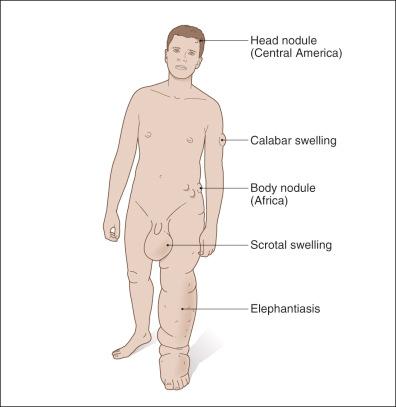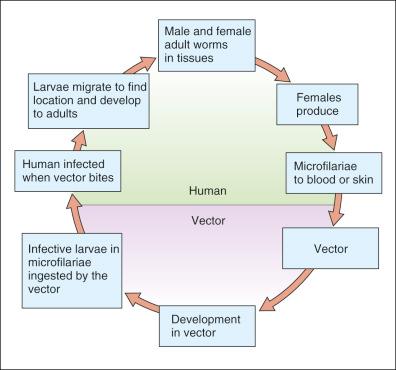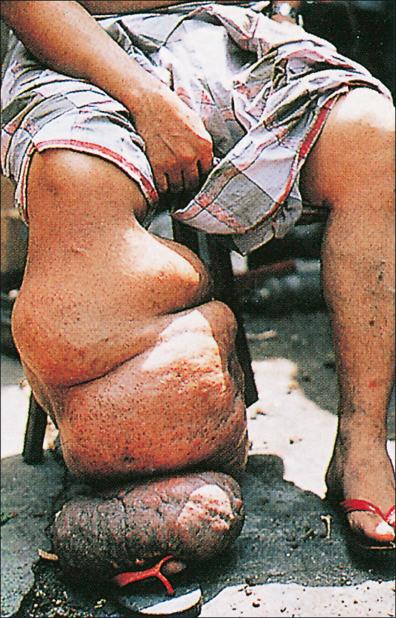Physical Address
304 North Cardinal St.
Dorchester Center, MA 02124
The filariases result from infection with insect-vector-borne tissue-dwelling nematodes. This group of nematodes is characterized by having a microfilaria stage of development between the egg and the fully developed larva.
Depending on the species, adult filariae may live in the lymphatics, blood vessels, skin, connective tissues, or serous membranes.
The females produce larvae (microfilariae) that live in the blood stream or skin.
All true filariae infecting humans are transmitted by dipteran vectors.
A few species of animal filariae may accidentally infect humans.
The transmission of human filariae is confined to warm climates: a high temperature is necessary for the parasites to develop in the vectors.
Wuchereria bancrofti : wuchereriasis, and Bancroft's filariasis
Loa loa : loiasis
Onchocerca volvulus : blinding filarial disease, Roble's disease, craw-craw, river blindness, and gale filarienne
Brugia timori
Mansonella ozzardi : Ozzard's filariasis, mansoneliasis ozzardi
Mansonella steptocerca
Brugia malayi : Wuchereria malayi , Microfilaria malayi , Filaria malayi
Dirofilariasis
The filariases are an important aspect of dermatologic medicine because the skin is one of the commonly affected organs. Filariases that affect the skin include Wuchereria bancrofti , Brugia malayi , Loa loa , and Onchocerca volvulus . Recently, their simultaneous occurrence in affected individuals has been shown in Africa.
The subcutaneous filariases lead to severe skin itch, papules, and scratch marks. Later the whole skin becomes dry and thickened. Skin hypo-, hyper-, and depigmentation may occur. Nodules may be formed.
The lymphatic filariases lead to lymphedema of the extremities, the vulva, scrotum, arms, and breasts. The legs often have a warty appearance with folds and cracks. Lymphatic filariasis is a disfiguring, disabling disease that makes life difficult. The physical consequences are pain, ugly swollen limbs, and bad-smelling skin. Life becomes difficult and simple actions like walking and working become impossible. The more the disease progresses, the more sufferers are shunned by society ( Fig. 7-1 ).

Filariasis has been a worldwide scourge of civilization for thousands of years. It was depicted on the pharaonic murals of Egypt and in the ancient medical texts of China, India, Japan, and Persia. Elephantiasis and hydrocele were first associated with parasitic filarial worms and their mosquito vectors in the late nineteenth century by French, English, and Australian physicians working with patients from Cuba, Brazil, China, and India. Lichenstein and Brug were the first to observe and describe the microfilaria of B. malayi . Macfie and Corson first identified microfilaria of Dirofilaria streptocerca in the skin of Ghanaians in 1922. Mansonella ozzardi was first described in 1897 by Manson.
Filariasis is only common in some tropical, coastal, and island areas of Africa, Asia, the Pacific, and the Americas. The prevalence of filariasis varies in the endemic communities. The disease has been observed in individuals aged 10 years and above. Men are equally affected as women.
Lymphatic filariasis, also known as elephantiasis and caused by W. bancrofti and B. malayi , now puts more than a billion people in at least 80 countries at risk. More than 120 million people are affected by lymphatic filariasis. One-third of those infected live in India, another third in Africa, and most of the remainder in South Asia, the Pacific, and the Americas. B. malayi is confined to Asia.
Infection by L. loa is limited to West and Central Africa. O. volvulus is endemic in sub-Saharan Africa, Central and northern South America, and in Yemen. In endemic areas the infection occurs throughout life.
Globally, the infection has been recognized as the second leading cause of permanent and long-term disability. The deforming, mutilating disease of the limbs and genitals results not only in physical crippling but also in serious psychosocial consequences.
Transmission of W. bancrofti is by mosquitoes of the genera Culex , Aedes , and Anopheles , while the vectors for B. malayi are mosquitoes of the genera Aedes , Anopheles , and Mansonia . L. loa is transmitted by species of flies of the genus Chrysops and O. volvulus by species of black flies of the genus Simulium .
Attacks of acute lymphangitis caused by filariae cause acute inflammation of part of a limb, joint, or a testicle.
Filarial worms cause a wide variety of clinical pathologies depending on the degree of host immune reaction to adults and microfilariae. In endemic zones for filariasis, studies of cellular and humoral immunity show near-universal seropositivity, indicating prior infection.
In lymphatic filariasis specific immunoglobulin E (IgE) titers are highest in people with tropical eosinophilia, lower in those with chronic lymphedema, and lowest in normal persons in endemic areas and those with asymptomatic microfilaremia. Conversely, asymptomatics have higher IgG titers to filarial antigens than symptomatic patients.
Most people in endemic areas are asymptomatic, probably because of the tolerance induced in utero.
Children of seropositive mothers have cord blood with IgE antifilarial antibodies. This reflects prenatal sensitization since IgE does not cross the placenta.
The major filariases – lymphatic filariasis caused by W. bancriofti and B. malayi , loiasis due to L. loa , and onchocerciasis due to O. volvulus – are solely human infections but dirofilariasis is zoonotic. As stated above, they may occur simultaneously.
The filarial worms are transmitted by a variety of blood-sucking insects to humans ( Table 7-1 ). The life cycle of the parasites is depicted in Figure 7-2 .
| Species | W. bancrofti | B. malayi | B. timori | L. loa | M. ozzardi | M. perstans | M. streptocerca | O. volvulus |
|---|---|---|---|---|---|---|---|---|
| GEOGRAPHICAL DISTRIBUTION | Tropics and subtropics, worldwide | SE Asia, Indian subcontinent | Indian Archipelago, Timor | West and Central Africa | Caribbean, Central and South America | Africa and South America | West and Central Africa | Africa, Yemen and Central and South America |
| VECTORS | Mosquitoes: Culex , Aedes , Anopheles , Mansonia | Mosquitoes: Mansonia , Anopheles , Aedes | Mosquitoes: Anopheles | Tabanid flies: Chrysops | Biting midges: Culicoides Black flies: Simulium |
Biting midges: Culicoides | Biting midges: Culicoides | Black flies |
| HABIT OF MICROFILARIA | Blood | Blood | Blood | Blood | Blood | Blood | Skin | Skin |
| PERIODICITY | Nocturnal | Nocturnal | Nocturnal | Diurnal | Aperiodic | Aperiodic | — | — |
| SHEATH | Present | Present | Present | Present | Absent | Absent | Absent | Absent |
| KEY FEATURES OF MICROFILARIAE | Short head space; dispersed nuclei; sheath unstained in Giemsa; body in smooth curves | Long head space; sheath stained pink in Giemsa; terminal and subterminal nuclei | Long head space; sheath unstained in Giemsa; terminal and subterminal nuclei | Single row of nuclei to hooked tail; filled end of tail; sheath unstained in Giemsa | Small size; long slender tail; aperiodic | Small size; blunt tail filled with nuclei; aperiodic | Slender shape; hooked tail filled with nuclei; occurs in skin | — |

The pathology of filariases results from the presence of adult worms in the tissues. In lymphatic filariasis the adult worms live in lymphatic vessels, mostly of the lymph nodes, pelvis, epididymis, and spermatic cord, and these adult worms cause the most significant lesions.
They release microfilariae into the lymph and they circulate in the blood stream with periodicity; the highest densities occur around midnight, coinciding with the time the vector will bite the host. Periodicity may also coincide with the sleeping and waking of the definitive host. It has been shown that the flow of chyle is greatest during sleep, possibly accounting for the surge of microfilariae into the blood at this time.
The periodicity may also depend on the cyclic parturition of the female worm.
Initially the worms cause only dilatation of the lymphatic vessels, leading to a thickened vessel endothelial lining, a chronic inflammatory infiltrate consisting of lymphocytes, plasma cells, and eosinophils adjacent to the worm or in the surrounding tissues. A granulomatous reaction occurs, leading to necrosis, degeneration of the worms, fibrosis, and obliteration of the lymphatics, and ultimately causing gross lymphedema ( Fig. 7-3 ).

In loiasis, the migration of the adult worm through the dermis or subcutis elicits an eosinophil reaction and edema. There is also dermal fibrosis.
In onchocerciasis, the pathology is due to the host's reaction to microfilariae in the dermis. There is increased dermal edema, perivascular inflammation, and small eosinophil abscesses around the degenerating microfilaria.
In endemic zones the exposure is universal, yet most people are asymptomatic.
Another common pattern is when individuals are asymptomatic, antibody-positive, and have microfilaremia.
Patients with acute lymphatic filariasis present with recurring malaise, fever, lymphadenitis, and perilymphadenitis.
Patients with lymphatic chronic obstructive pathology present with either hydrocele or elephantiasis. The arm, breast, scrotum, or vulva may be involved, and there may be chyluria.
A small proportion of patients have tropical eosinophilia.
Patients with L. loa may present with swellings known as calabar or fugitive swellings on any part of the body.
Dead worms (within nerves) may cause neurological deficits, including parasthesiae or paralysis.
Itching and scratching are often the first manifestations of onchocerciasis, followed by altered pigmentation. Patients may also present with wrinkling, papules, edema, and a skin that appears like a leopard's or a lizard's skin.
Tumors may also be formed over bony prominences.
Take a thorough history and examination of the patient.
Most patients present late with features of chronic infection, having acquired the infection a year or more earlier. Clinical manifestations include woody edema, which involves the lower extremities or the genitalia. The upper limbs and mammary glands of women are the next common site. Some patients with elephantiasis develop a crusty, warty skin over the lower extremities and this is called mossy foot.
In the skin, onchocerciasis leads to severe itch as a major presenting complaint. Later the whole skin becomes thickened, dry, and lichenified. There is loss of elasticity (hanging groins, Fig. 7-4 ).

Onchonodules and tumors can be seen and palpated, in particular above the hip bones, but also elsewhere.
In loiasis an adult worm migrating beneath the conjunctiva or below the skin may be the first indication of infection. Calabar swellings may develop in any portion of the skin, but are more frequently seen around the wrists and ankles. Onset is sudden but the swellings regress gradually.
Microfilariae are found in the blood and skin but they can also be found in bone marrow preparations, cervical smears, urine, fine-needle aspirates, and hydrocele fluid.
The tests here include:
Stained thick blood films for identification of microfilariae: stains used include Giemsa and hematoxylin
Capillary blood examination for the presence of microfilariae.
Skin snips are taken to detect microfilariae of O. volvulus and Mansonella streptocerca that reside in the skin (see Onchocerciasis , Patient evaluation, diagnosis, and differential diagnosis , below, for further details).
The centrifuged sediment is examined for microfilariae. Slides can be stained or fixed.
Become a Clinical Tree membership for Full access and enjoy Unlimited articles
If you are a member. Log in here